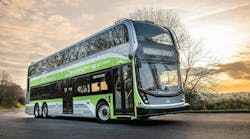Electric buses powered by on-route wireless charging present one possible solution in the fight against climate change. On that front, Seattle will be the first location in North America to deploy double-decker electric buses with InductEV inductive wireless charging.
The Central Puget Sound Regional Transit Authority, known as Sound Transit, has ordered 33 zero-emission Alexander Dennis Enviro500EV double-decker electric buses and 15 60-ft. articulated electric buses powered by 13 300-kW in-ground inductive chargers. The buses will be used on the new Stride bus rapid transit service.
The King of Prussia, Pa.-based InductEV's technology avoids wired, depot-oriented charging methods that consume considerable real estate and electric utility assets. It enables wireless-charging interoperability for both double-decker and 60-ft. articulated electric buses on commuter routes. InductEV maintains a wireless Research & Development Center housed in a 50,000-square-foot facility at the company’s global headquarters.
NFI subsidiary Alexander Dennis designs and manufactures double-deck buses; it’s the UK's largest bus and coach manufacturer. The firm has over 31,000 vehicles in service in the UK, Ireland, Europe, Hong Kong, Singapore, New Zealand, Mexico, Canada, and the U.S. Upon delivery, expected in 2026, the double-decker buses will serve a new bus rapid transit route being developed by Sound Transit along Interstate 405 to connect communities around Lake Washington and to the agency’s light rail network.
"The inclusion of Alexander Dennis marks an exciting new chapter for InductEV," explained Brandon Anulewicz, Chief Revenue Officer for InductEV. "Together, we'll grow the company's existing footprint and, by so doing, accelerate the benefits of wireless inductive charging technology in the commercial and municipal transport sectors."
Steadily Expanding Wireless-Charging Tech
This rollout will make Sound Transit the seventh transit agency in Washington State to deploy InductEV's patented wireless-charging technology. The company’s technology is currently in use or scheduled for deployment in approximately 100 electric buses throughout the state, along with 35 in-ground wireless-charging pads. Indianapolis and Martha’s Vineyard in Massachusetts also run electric buses with the wireless-charging system.
Daytime on-route wireless charging also enhances the use of renewable energy for electricity versus in-depot wired charging at night. Sound Transit will charge its buses on-route and in depots since nearly half of the electricity in the Puget Sound region comes from renewables.
InductEV's wireless-charging technology debuted in the state in 2017 with Link Transit in Wenatchee, Wash. According to the company, by using its solution, Link Transit was able to achieve a 17-hour duty cycle and a 1:1 diesel replacement ratio.
The electric buses will rely on 13 300-kW in-ground inductive chargers. Wireless charging is over 20% more cost-efficient than wired charging and 30% to 50% more cost-efficient than diesel, according to InductEV.
How Does the Charging System Work?
The system transfers power from the grid to the in-ground wireless-charger pads to charge the vehicle wirelessly. Buses receive electricity through magnetic induction from the in-ground charger and transfer it to the battery for charging. The power cabinet can be placed up to 100 feet away from the Ground Charger, further freeing up real estate.
InductEV has been granted three recent patents by the U.S. Patent Office. This brings the number of patents it holds to 18, with 23 more pending. One of the new patents covers opportunity charging for taxi queues—idling vehicles can take advantage of the unobtrusive InductEV wireless power-transfer stations set into the pavement of each queue to recharge their internal battery packs.
Such Strategic Opportunity Charging converts the wait for passengers into a useful endeavor. This approach has already been applied to a taxi fleet in Gothenburg, Sweden. As more taxi vehicles become autonomous, wireless charging will be one key for market growth.
Another patent is for an air-cooled subsurface vault for wireless power-transfer systems. In these cases, at least two grates are positioned on respective sides of the wireless power-transfer charger to enable bidirectional airflow between the surface and the air space around the charger. This approach is said to enable more efficient energy transfer and greater system reliability, while completely removing the need for any power electronics cabinets to be installed at the site
The third patent covers passive arc detection and mitigation in wireless power-transfer systems. "We have a relentless focus on product improvements, R&D, and knowledge gained in-the-field,” said Tony Calabro, CTO and Chief Product Officer, InductEV. “Each of these new patents is a direct result of that emphasis on practical application development with continuous improvement.”
“With a large number of installations of our wireless-charging technology now operating in North America and Europe, we have gained considerable insights into what works and what needs improvement,” added Calabro. “Fortunately, we’ve been at this for more than a decade and are now seeing the results of our investment in research & development in both patent awards and rapidly accelerating commercial adoption.”
To date, InductEV has delivered over 1.5 GWh of energy to customers across the U.S. and the EU through its wireless-charging networks—the equivalent of saving 650 metric tons of CO2, according to the company.
